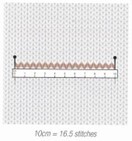Part 1 – Yarn ply, weight & Length?
4-ply, 8-ply, 12-ply, 14-ply, double-knit, triple-knit, chunky, bulky…
My head is spinning - how do I get the right yarn for my project?
There are several different ways to describe yarn thickness. It’s confusing for new knitters, and some of us older ones too.
Traditionally ply referred to the number of strands that were twisted together to make a yarn. The strands were mostly the same thickness, so more strands ‘plied’ or twisted together meant thicker yarn.
In the modern world there are more types of wool and other materials of more thicknesses, and more manufacturing methods, that can be used to make a knitting yarn. The old term Ply is sometimes still used to indicate the number of strands but no longer means the thickness of the yarn. Now a single ply, low-twist yarn be made super-bulky and knitted on 10mm to 20mm needles, and a high-twist multi-ply yarn can now be light, medium or heavy weight meaning anything from very thin to very thick.
In New Zealand and Australia Ply is almost always now used to refer to the thickness of the yarn not to the number of strands twisted together. Used this way a higher ply number means a thicker yarn. This can be different to North America, Europe and UK who may still use it the old way. We were the largest knitting yarn manufacturers in the world, so we made the rules, right?
Converting overseas patterns now takes a little more thought. The table in Part 2 gives the modern “Ply” number as used in NZ, along with a description of use, and equivalent North America & International words for yarn thickness. The most common yarn in North America is “worsted” weight, which is our 10 ply or Aran* weight. The most common weight in NZ is 8-ply, which is the same in Australia and the UK.
*Aran can mean 10 ply weight, or a pattern with lots of cables as derived from the Aran Isles in the UK. If it’s an Aran cable pattern it could be knitted in 8 ply, 10 ply, or sometimes 14 ply.
Thickness can also depend on what the yarn is made of and how it is twisted. A smooth tightly twisted yarn will knit up tighter on a smaller range of needles size. A fluffy or lightly twisted yarn gives extra ‘loft’ which allows for knitting tighter for more structure and warmth, or looser for more a lighter garment. Mohair is the best example of this, although it is longer than most other 12 ply yarns, it usually knitted on 5.50 mm needles to provide a light and airy finish.

Remember to do a tension square or check your tension after you get started. Then you can easily adjust needle size or garment size to get the right size at the end, without having to pull-down and re-knit the whole garment. Measuring your tension helps you decide if you are normally a tight, average or loose knitter, so in future you can adjust needle size before starting a project. This is even more important if using an overseas pattern or using a different yarn to what the pattern states.
Part 2: https://knitsewquilt.nz/blog/ply-weight-length-a-better-understanding-part-2/
And finally… If you have a topic that you want covered or a tip of your own to share, please contact me.
Happy knitting.
Fern
Knit Sew Quilt NZ
